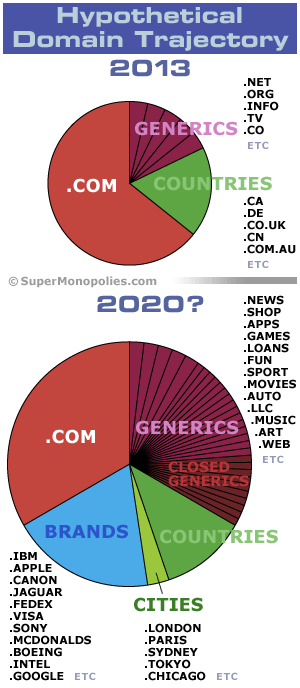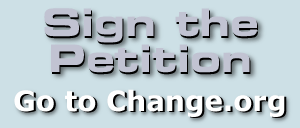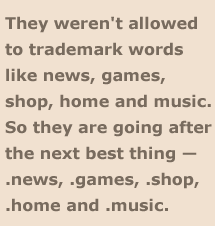 |
|
The Future
Given that the .com string is universally acknowledged to be the domain gold standard, it's hard to imagine a different future. The current situation is so unpredictable and unprecedented that I'm only prepared to make hypothetical speculations here, not predictions.
They weren't allowed to trademark words like news, games, shop, home and music. So they are going after the next best thing — .news, .games, .shop, .home and .music. Domain names that in their innate exclusivity act like virtual trademarks. The combined impact of the new domain extensions and current non dot com strings could challenge or erode the present dominance of the dot com domains. This is illustrated in the hypothetical pie charts at left. But the magnitude of the impact of the coming domain name explosion is anyone's guess really. Currently, the .com string is many times more valuable than the sum total of all its rivals. However, it is also plausible that once 1,000 new domain extensions are created, their combined value could in turn eclipse the .com domains. The new domains are coming. Domains Act As TrademarksSince I wrote the above, a number of objections on the ICANN closed generics forum have also raised the compelling trademark issue, for example:
That's the expert opinion of the American Intellectual Property Law Association. Read more on the ICANN Forum 1 and other forum pages. Then there's the opinion of Professor J Thomas McCarthy, one of the world's foremost authorities on trademarks, with David J Franklyn:
Read more on the ICANN Forum 2 page. As you can see, permitting closed generic TLDs will circumvent trademark law. Rise Of The Dot BrandsMany of the Fortune 500 companies have applied for their own brand TLD. In a fascinating interview at highly respected blog DomainSherpa, Xavier Buck of EuroDNS hypothesizes that a massive growth in domain registration and implementation will follow from the new domain releases. While he is personally somewhat sceptical about the non-brand strings, he is remarkably bullish about the dot brands. Speculation about the impact and ramifications of the dot brands (and more about the thought provoking Xavier Buck interview) is presented on the Brand Domains page. As stated, .com is the gold standard of domains. But if billions of dollars are spent on dot brand marketing, the 'tipping point for acceptance' could well be passed... A private dot brand could well become de rigueur for any leading edge corporation. To not have one's dot brand would appear "small time", old fashioned and inferior. The brand domains could become a very significant addition to the scope of the internet.
Closed gTLDs like .beauty have the potential for creating unfair monopolies in many significant industries. See also the dot beauty page. The Domain is the Brand is the Trademark. L'Oréal's application says they intend to deploy around 10,000 .beauty domains for their own use (with none to be sold to competitors). This real, official statement of intention gives an insight into the possible plans of the many companies who have applied for their own domain strings. (Especially since Super Monopolies admits to only having read a small number of relevant application documents so far.) Companies like Apple, Bridgestone, Fedex, Google, Heinz, IBM, Microsoft, Philips, Shell and Sony to name just a handful of the hundreds. If these companies roll out thousands of new websites comensurate with L'Oréal's .beauty plan, then we are about to see hundreds of thousands of new sites, backed by most of the world's largest and wealthiest corporations. Backed by many of the world's most effective and experienced marketers and advertising agencies. It's hard to imagine the impact won't be massive. Unimaginable really. Iphone.apple, Cloud.microsoft, FunnyVideos.youtube, JustDoIt.nike, OhWhatAFeeling.toyota. Actually that's a trend I don't mind predicting will be popular — company slogan + dot + brand... Oh What A Feeling + Toyota = OhWhatAFeeling.toyota When it comes to the brand domains, the haves will spare no opportunity to leverage their advantage over the have nots. This window of opportunity will probably last for around three years. Then a new round of applications for TLDs starts. Tipping PointThere is no chance of .com being surpassed as a TLD by a single rival in the next decade or two, but I do expect to see wide acceptance of a multitude of new strings. The sheer volume of the new domains is enormous. And the demand is similarly enormous. Imagine the impact of Google spending tens of millions of dollars promoting some new "essential" service on .search, for example. Something so compelling that we all go daily to movie.search for example. Imagine if Google comes up with some new "have-to-have" service called Cloud.google. Now imagine if Google relentlessly advertises this service across their vast network and on YouTube too. These ads are free to the owners, but for anyone else, they might cost $50m. So Google's potential ad campaign could be worth $50m for example, though they wouldn't be actually spending the cash. Add another $20m ad spend on other peoples' networks. Hundreds of scenarios like these involving other leading global corporations will surely drive public acceptance of the new gTLDs. How could most of the Fortune 500 be wrong — how did they become the Fortune 500 in the first place?
Some incredible cool new must-have service, that if I knew what it was — well I wouldn't mention it here! And for US readers, don't forget that people in most other countries are quite used to using domains other than .com, the USA is about the only country that hasn't closely embraced it's own string — .US What will be the first million dollar new gTLD domain? There will be many, many contenders, from Download.games to Loan.bank to Web.security to Toy.store to Data.cloud. I would bet on Life.Insurance though it will likely never make it onto the open market. I won't even mention the adult names...
The new domains are coming. The tipping point may be about to be passed. Gold RushThe net is young in historical terms, just one generation old. The rise of the domain investment industry has often been likened to a gold rush, like those that occurred more than 100 years ago in Australia and California. And among the 22 non country code domains that came to exist in the first 25 years of the web, the .com string came to represent the "gold standard". Top names like Business.com were and are worth millions and sold for millions. The internet has also often been compared to the "wild west" — which resonates well with the gold rush model of the domain name market. And partly due to good luck (but mainly due to a general lack of foresight about what was to come) the web evolved into a reasonably fair network. More than 2,000 registries sell domain names to millions of buyers around the world, and access is arguably reasonably fair. Luckily, it took years for people to realize the value of domain names. And it took years for dot com to emerge as the gold standard of domains. So in the early days, domain names distributed themselves more or less fairly in accordance with the actual needs of those who registered them. There were no domain investors in the early days to vacuum them up en masse. But it's different now... The lessons are there to see. But ICANN can't see it. They are permitting applications for closed registries on words that belong equally and justly to every citizen of the world. No trademark office in the world will permit you to trademark the word Shop® but ICANN is allowing Amazon to apply for sole ownership of every single .shop domain in the world — which is effectively the same thing. In the 1880s, 200,000 prospectors were able to search for gold in Sovereign Hill at Ballarat, Australia where the world's richest ever gold lode was discovered. But back to the future in 2013, instead of issuing 200,000 prospecting licences for some domain strings, ICANN will only issue one. This is a valid analogy. ICANN is selling off entire goldfields to some of the world's largest corporations, who will then set up private walls around them. ICANN has failed to learn the lessons of history and will likely preside over the rise of super monopolies in the domain name system. The proven wisdom of the separation of registry, registrar and registrant is being discarded. We may be witnesses to the dawn of the private internets. Once they have formed, they will be unprecedented and very, very powerful.
|
|
|
SuperMonopolies.com — A hypothetical analysis of the new top level domain names — coming in 2013-14.
----- ----- ----- ----- -----
Alarm Media SUPER
MONOPOLIES ™ IS PART OF THE ALARM MEDIA ENTERTAINMENT & BUSINESS
NETWORK PREMIUM
BUSINESS DOMAIN NAMES FOR SALE FROM THE NETWORK © 2012-13 David Tyrer All rights reserved Website by Click as a Flash Terms and Conditions
|
||



 Domain
names have a similar power and invincibility as trademarks...
Domain
names have a similar power and invincibility as trademarks...